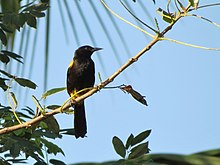Puerto Rican oriole
| Puerto Rican oriole | |
|---|---|

| |
| Scientific classification | |
| Domain: | Eukaryota |
| Kingdom: | Animalia |
| Phylum: | Chordata |
| Class: | Aves |
| Order: | Passeriformes |
| Family: | Icteridae |
| Genus: | Icterus |
| Species: | I. portoricensis
|
| Binomial name | |
| Icterus portoricensis H. Bryant, 1866
| |

| |
The Puerto Rican oriole (Icterus portoricensis) is a species of bird in the family
The Puerto Rican oriole was previously grouped with
Habitat
The oriole is
Behavior
After breeding, adult Puerto Rican orioles and their young will remain together in a family group. It primarily forages in dense vegetation looking for a wide range of foods that includes fruits, insects, lizards, and nuts and grains.[3]
Description
Males and females are similar in size and color. Males weigh about 41.0 grams and females weigh about 36.6 g. The average wingspan of males and females is 96.9 and 92.1 mm, respectively.[4] In 2008, Hofmann, Cronin, and Omland, conducted a study that showed there is little color difference in the feathers between the males and females of many tropical orioles, including the Puerto Rican oriole.[5] This means that males and females both have elaborate colors, in contrast many temperate-zoned birds have brightly colored males and dull colored females.
Adults are black with yellow on their lower belly and shoulder. The closely related Hispaniolan oriole (Icterus dominicensis) and Bahama oriole (Icterus northropi) have more yellow on their bodies, but, the Cuban oriole (Icterus melanopsis) has more black.[3]
Communication
Both males and females of the Puerto Rican oriole sing with no obvious difference in song structure. The
Reproduction
Most members of this genus are thought to be
See also
- Fauna of Puerto Rico
- List of birds of Puerto Rico
- List of endemic fauna of Puerto Rico
- List of Puerto Rican birds
- List of Vieques birds
- El Toro Wilderness
References
- . Retrieved 12 November 2021.
- ^ Chesser, R. T., R. C. Banks, F. K. Barker, C. Cicero, J. L. Dunn, A. W. Kratter, I. J. Lovette, P. C. Rasmussen, J. V. Remsen, Jr, J. D. Rising , D. F. Stotz, and K. Winker. 2010. Fifty-first supplement to the American Ornithologists’ Union Check-list of North American Birds. Auk 127(3):726-744.
- ^ a b c d e Jaramillo, A., P. Burke. 1999. New World Blackbirds. Princeton: Princeton University Press.
- ^ a b c d Garrido, O., J. Wiley, A. Kirkconnell. 2005. Genus Icterus in the West Indies. Ornitologia Neotropical, 16: 449-470.
- ^ Hofmann, C., T. Cronin, K. Omland. 2008. Evolution of sexual dichromatism. 1. convergent losses of elaborate female coloration in New World orioles (Icterus spp.).Auk, 125: 778-789.
- ^ Price, J., N. Friedman, K. Omland. 2007. Song and plumage evolution in the New World orioles (Icterus) show similar lability and convergence in patterns. Evolution, 61: 850-863
- ISSN 0003-3472.
- ^ Price, J., S. Lanyon, K. Omland. 2009. Losses of female song with changes from tropical to temperate breeding in the New World blackbirds. Proceedings Royal Society of London, Biological Sciences, 276: 1971-1980.
- ^ Campbell, S.K., A.L. Morales-Perez, J.F. Malloy, O.C. Muellerklein, J.A. Kim, K.J. Odom, and K.E. Omland. 2016. Documentation of female song in a newly recognized species, the Puerto Rican Oriole (Icterus portoricensis). Journal of Caribbean Ornithology 29:28–36
]

